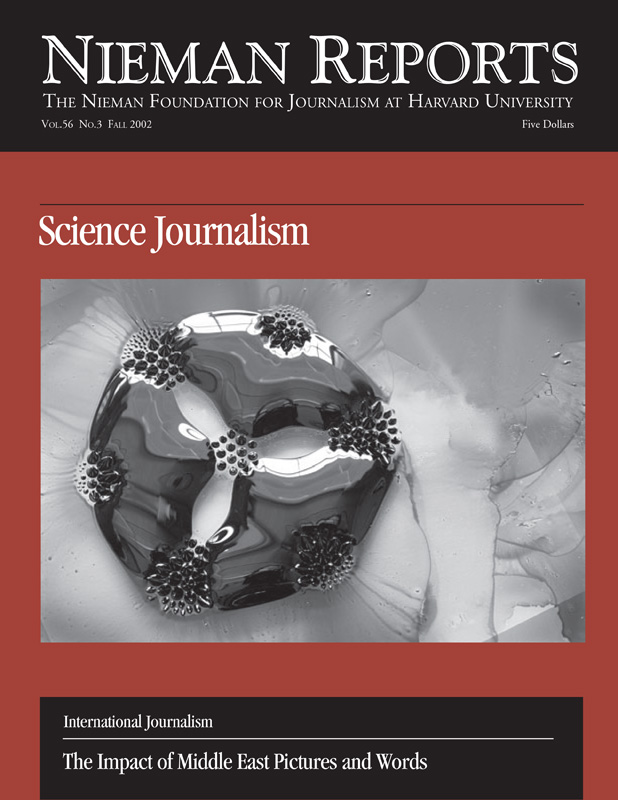I knew not to ask their names and concentrated on the girlishness belied by their suicide belts and kalashnikovs. Subtle feminine clues appeared. They whispered to each other behind cupped hands in front of their covered faces. A small delicate wristband, purple platform sandals, or long-lashed wide eyes peeked out from their militant attire and offered up contradictions.
It’s often a simple gesture or small symbols in a larger political context that gives a photo its strength and offers some universal humanness. But after covering breaking news in the Middle East for four years, I fully realize the political repercussions of stories like this and sadly know both sides often cannot see each other as human.
It took four months of preparation consulting with a writer to arrive at this meeting of female suicide bombers with the al-Aqsa Brigades, training for future operations inside Israel in a small Palestinian camp in Northern Lebanon. I own all rights to these possibly contentious photos of female suicide bombers. After their first publication in a Sunday supplement to a Scottish newspaper, The Herald, I will make sure they do not get published alongside text that offers some sort of biased argument for one side or the other. My hope still is that photographs such as these can prompt people to ask why people do the things they do. But I have learned how difficult it is to work in this region, where tempers simmer beneath a thin veneer of calm, and those on all sides constantly accuse journalists of bias.
Four years ago, as a photojournalist, I brought myself to the Middle East and settled in Beirut. The 10-year ban on Americans traveling to the country had been lifted 14 months earlier, and the city had become one of the largest reconstruction sites in the world. Yet editors I visited before my move told me they didn’t have much need for stories from this region.
Often my introduction to the culture was lightly amusing. On a Hezbollah press tour, one of the first of its kind, an overexcited assistant press officer kept trying to tell me that Hezbollah suffered from its stereotype as a terrorist organization. “It’s a stereotype, they think we are the terrorist!” he said. I raised an eyebrow ironically and asked rhetorically that maybe I, too—an American woman in the Middle East—could understand what it meant to be a stereotype? “Yes, yes,” he exclaimed, “It is true, it is true, they think we are the terrorists and you are the sex machine!”
But after the Israeli withdrawal from South Lebanon, the death of Syrian President Hafez el-Assad, and the start of the Palestinian Intifada in 2000, things changed considerably. Then the events of September 11 sparked an almost hysterical demand for news from the Arab world. As an American and native New Yorker, the political became intensely personal.
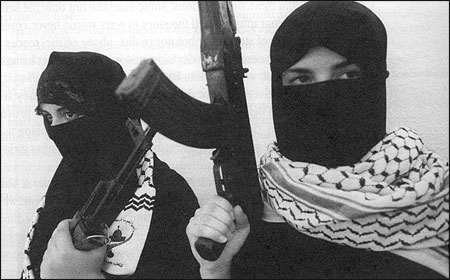
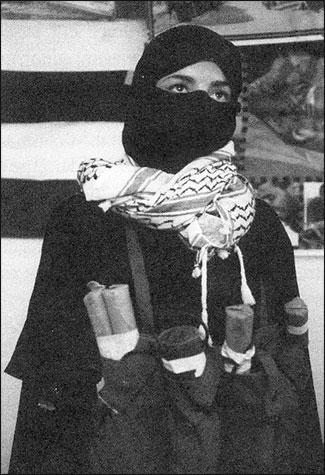
These unidentified girls from the Beddawi Palestinian camp in Tripoli, Lebanon, have volunteered to be suicide bombers for the al-Aqsa Brigades in future operations inside Israel. As Kealy writes, “My hope still is that photographs such as these can prompt people to ask why people do the things they do. But I have learned how difficult it is to work in this region, where tempers simmer beneath a thin veneer of calm, and those on all sides constantly accuse journalists of bias.”
On a Sunday in mid-December 2001, I was on assignment in Ain el-Helweh. More than 70,000 Palestinians live there, making it the largest Palestinian refugee camp in Lebanon. Hamas, the Palestinian Islamist group, organized a rally to commemorate their 14th anniversary. My purpose was to merely cover this small event inside the camp to show the Palestinian refugees in Lebanon supporting Hamas’s actions inside Israel and the occupied Palestinian territories. Although the organization had taken responsibility that weekend for suicide bombings that killed more than 25 people in Israel, leaders from Hamas have stated that they do not conduct military training or operations from inside Lebanon.
Children in the Palestinian refugee camps often trail alongside me repeating in high pitched voices “saurini, saurini, saurini,” which in Arabic means, “take my photo, take my photo, take my photo.” They love to pose for photos when a photojournalist arrives. I used to view it as a distraction to my concentration, but realizing how it amuses them I now take the time to snap my shutter when they ask. By the end of the march of Hamas supporters through the camp that day, I felt relaxed and very aware of the multitudes of children darting through the crowds. Girls shyly followed me around, a curious female presence, no headscarf, clearly foreign, and doing what is thought of as a man’s job.
As some adults listened to a Hamas spokesman’s speech, others readied themselves for the requisite end-of-the-rally burning of the Israeli and American flags. I walked through the red dirt soccer field to where small boys dressed in camouflage with pint-size plastic machine guns and teenage boys dressed as suicide bombers covered head to toe in white sheets and fake belts of explosives, waited on the sidelines.
I knelt down on the ground, eye-to-eye with a small boy about three years old, a Hamas headband wrapped around his forehead. A young teenager suddenly approached, untied his fake suicide belt and tied it around the waist of the little boy. I didn’t say a word, waiting to see what would happen. He secured it around the little boy’s waist as he lifted his arms and smiled shyly. Then the boys straightened up, pulled their hoods over their faces and fell into a chilling tableau. The boys clearly didn’t understand the significance of their gestures, but they had already absorbed the message of the roles they were expected to embrace.
The little Palestinian boy was about the same size and age as my nephew, Harrison, who was in love with the firemen in New York City before he could talk. In my wallet I carried a photo of Harrison dressed as a fireman on his second birthday, smiling widely.
I had hoped people would view this boy from Ain el-Helweh as I had seen him, a tiny tragic figure.
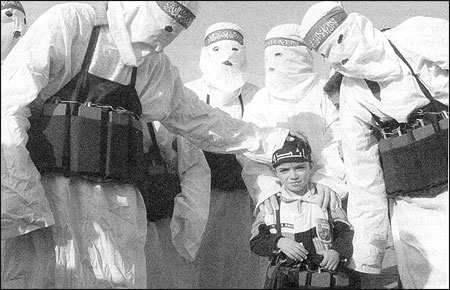
Ain el-Helweh, Lebanon: Palestinian children dressed as suicide bombers put fake explosives on a small child after marching in commemoration of the 14th anniversary of the Palestinian militant group, Hamas, in Ain el-Helweh, the largest Palestinian refugee camp in Lebanon, on December 9, 2001. The camp is home to more than 40,000 Palestinian refugees and is surrounded by Lebanese Army checkpoints.
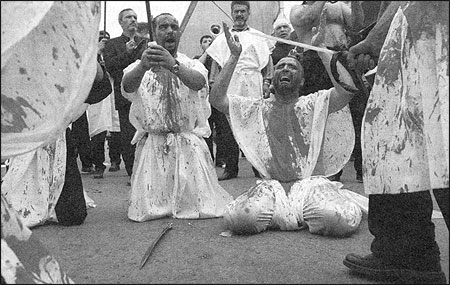
Nabatieh, South Lebanon: Ashoura, the annual religious holiday in which Shiite Muslims sacrifice their blood to commemorate the death of Hussein, the grandson of the Prophet Mohammed, who died in battle in 680 AD in Kerbala, now modern day Iraq. The battle marks the schism between Sunnis and Shiites. The practice was banned in Iran in 1994; members of Hezbollah in Lebanon also denounce it, although it still occurs annually in other countries, such as Afghanistan and Pakistan.
Within a few days the photo was being published worldwide by my agency, Getty Images. I had worked on a $225 day rate and received no other royalties for the publication of this photo, yet I felt incredibly compensated by seeing it in print and hearing that it had been discussed on morning radio shows in New York City. But in March, an unwitting salesperson at Getty Images made an unfortunate mistake by selling the photo for an advertisement published by the American Jewish Committee on the opinion page of the Sunday New York Times with the headline “Some are born hating, others are taught how to hate.”
I feel that this child is not emblematic of what needs to be fought against but rather serves as a symbol of a people whose desperation needs to be addressed. The ad only causes more rifts and hatred by using the image of this small child. To portray a three-year-old as a symbol of hate and evil buried the humanitarian intent of the photo.
I worried that the mistaken use of this photo would lead to problems for me in Lebanon. It is offensive to me that a spokesman for the American Jewish Committee expressed concern about my safety in an article addressing the misuse of my photograph. While it would be nice to see this as an expression of genuine concern, unfortunately I see it as serving a more insidious political agenda: I regard it as trying to reinforce an image of the Arab world as populated only with extremists and teeming with terrorists.
Breaking news footage on September 11 had already done a lot of damage in this respect. Before anyone knew the scale of events that would unfold, some local stringers rushed into Ain el-Helweh for reaction photos. A few Palestinians danced and cheered for the cameras. After this initial display the streets were quiet and darkness fell a few hours later. Time and Newsweek published these pictures as indicative of widespread jubilation among Palestinians at the September 11 tragedy and U.S. TV news stations ran images like these in continuous replays.
However, there was never any genuine street reaction to photograph in the Palestinian camps in Lebanon or elsewhere that day. When my brother called to reassure me that my family in Manhattan was alright, he asked, clearly shocked, “Why is everyone celebrating over there?” I explained the news footage portrayed a few small crowds as a collective whole: There had been a small crowd early in the day in a Palestinian camp in Lebanon, a small group of kids handing out candy in East Jerusalem, and a large demonstration in Nablus, a West Bank town. This irresponsible use of the same footage over and over in a rush to offer something from the Middle East and Arab world demonized the Palestinians.
I am very aware that most Americans cannot distinguish between Arabs of different nationalities, religion and loyalties in this region. I do cover breaking news, which often involves militant extremist groups, and so I document their speeches, parades and anniversaries, whether it be the Shiite group Hezbollah, the Palestinian Sunni group Hamas, or others. The images do carry a particular weight, but to many uninformed viewers they represent the whole as opposed to the fringe groups that they are.
In my work I concentrate on small segments of society. When photojour-nalists focus on aspects of European and North American culture, most viewers of the images understand that the photo essay or long-term body of work represents specific problems, social and political, and the consequences of these difficulties. The groups whose images I capture represent certain political, social and cultural issues in this region, but in no way do they reflect the 2000 years of diverse civilizations that have formed today’s complex “Arab world.”
In spite of the mistaken sale of my photo of that little boy from Ain el-Helweh, I feel I can trust my agency completely, and this is crucial. In this day of digital, light-speed photojournalism, I must move images from my camera through e-mail to editors instantly with a detached objectivity. And there is no time for mistakes. This can be a difficult balance to strike, emotionally and physically wearing, but it is vital to maintaining the integrity of these images.
Courtney Kealy, a photojournalist for Getty Images, is based in Beirut, Lebanon. Her work has appeared worldwide in such publications as The New York Times, Los Angeles Times, US News & World Report, Time and Newsweek. She also freelances as a local producer for ABC News.


